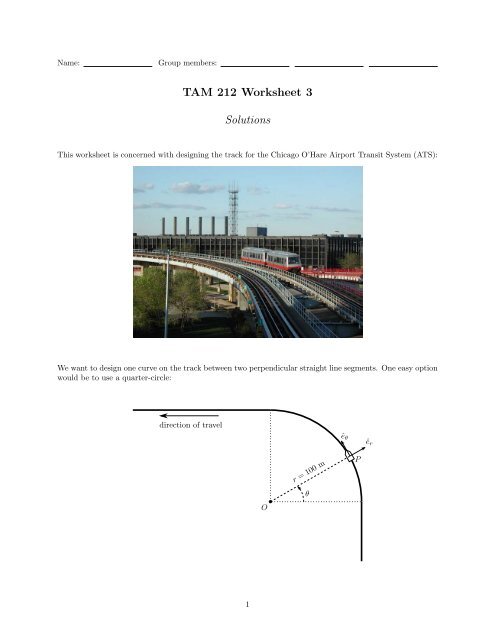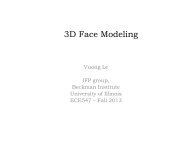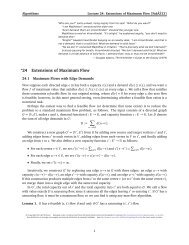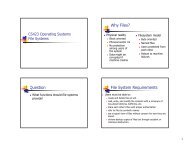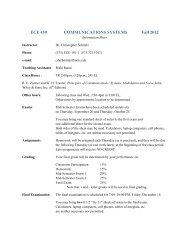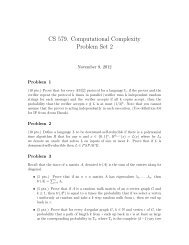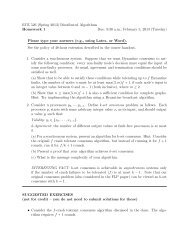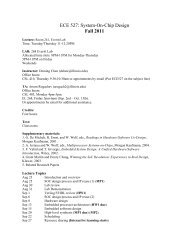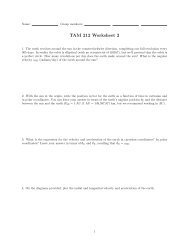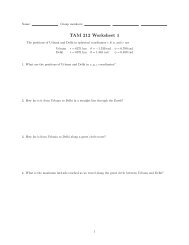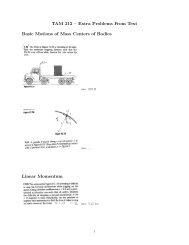TAM 212 Worksheet 3 Solutions
TAM 212 Worksheet 3 Solutions
TAM 212 Worksheet 3 Solutions
You also want an ePaper? Increase the reach of your titles
YUMPU automatically turns print PDFs into web optimized ePapers that Google loves.
Name: Group members:<br />
<strong>TAM</strong> <strong>212</strong> <strong>Worksheet</strong> 3<br />
<strong>Solutions</strong><br />
This worksheet is concerned with designing the track for the Chicago O’Hare Airport Transit System (ATS):<br />
We want to design one curve on the track between two perpendicular straight line segments. One easy option<br />
would be to use a quarter-circle:<br />
direction of travel<br />
1<br />
O<br />
r = 100 m<br />
θ<br />
êθ<br />
P<br />
êr
1. If the train moves around the track at constant speed v = 10 m/s, what is its angular velocity ω about O<br />
while on the circular segment?<br />
ω = 0.1 rad/s<br />
2. Plot the radial ar and angular aθ components of the train’s acceleration a = ar êr + aθ êθ versus θ as the<br />
train moves around the circular segment. Clearly mark all significant points on the vertical axis.<br />
1<br />
0<br />
1<br />
ar<br />
Π<br />
4<br />
Π<br />
2<br />
Θ<br />
3. On airport trains people are normally standing. As the lead engineer for the ATS system design, do you<br />
anticipate any problems for the passengers on this train as it goes along this track?<br />
The radial acceleration will suddenly jump from zero on the straight-line segments to −1 m/s 2 on the curve.<br />
This will be uncomfortable for the passengers who will feel this as a sudden jerk sideways.<br />
4. To give the passengers a smoother ride, we want to make the track have a radius r that varies with the<br />
angle θ, so r = r(θ), while still keeping a constant angular velocity ˙ θ = ω. Use the chain rule to find ˙r and<br />
¨r and so write the acceleration in the polar basis in terms of r ′ (θ), r ′′ (θ) and ω. Here r ′ (θ) is the derivative<br />
with respect to θ.<br />
The chain rule gives ˙r = r ′ ˙ θ and ¨r = r ′′ ˙ θ 2 + r ′ ¨ θ. Also ˙ θ = ω and ¨ θ = 0, so<br />
a = (¨r − r ˙ θ 2 )êr + (r ¨ θ + 2 ˙r ˙ θ)êθ = (r ′′ − r)ω 2 êr + 2r ′ ω 2 êθ<br />
2<br />
1<br />
0<br />
1<br />
aΘ<br />
Π<br />
4<br />
Π<br />
2<br />
Θ
5. From now on we will keep ω fixed at the constant value from Question 1 and we will use the functional<br />
form:<br />
<br />
2<br />
r(θ) = Aθ θ − π<br />
2 + 100 m<br />
2<br />
where θ is in radians and A is an unknown constant. This function looks like:<br />
100<br />
r<br />
0<br />
0<br />
Π<br />
4<br />
Using this function, what are the radial and angular components of the acceleration when the train just<br />
enters the curved track segment?<br />
Evaluating the above acceleration expression with this r(θ) gives:<br />
<br />
2<br />
r(θ) = Aθ θ − π<br />
2<br />
r ′ <br />
(θ) = 2Aθ θ − π<br />
r ′′ <br />
(θ) = 2A θ − π<br />
2<br />
The acceleration at θ = 0 is thus:<br />
2<br />
2<br />
2<br />
2<br />
+ 100 r(0) = 100<br />
<br />
2<br />
+ 2Aθ θ − π<br />
<br />
2<br />
r ′ <br />
+ 8Aθ θ −<br />
(0) = 0<br />
π<br />
<br />
+ 2Aθ<br />
2<br />
2<br />
r ′′ (0) = Aπ2<br />
2<br />
2 Aπ<br />
a =<br />
200<br />
ar = Aπ2<br />
− 1<br />
200<br />
aθ = 0<br />
<br />
− 1 êr<br />
6. What value of A will give an acceleration profile that does not abruptly jump when moving onto the curve<br />
from the straight-line segment?<br />
To have zero initial acceleration on the curve we need A = 200/π 2 ≈ 20.3 m.<br />
3<br />
Π<br />
2<br />
Θ


